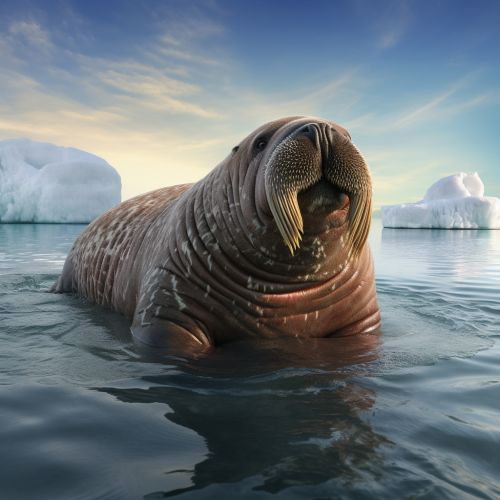Walrus
Taxonomy and Evolution
The walrus (Odobenus rosmarus) is a large flippered marine mammal with a discontinuous distribution about the North Pole in the Arctic Ocean and subarctic seas of the Northern Hemisphere. The walrus is the only living species in the family Odobenidae and genus Odobenus. This species is subdivided into three subspeciesSubspecies: the Atlantic walrus (O. r. rosmarus) which lives in the Atlantic Ocean, the Pacific walrus (O. r. divergens) which lives in the Pacific Ocean, and O. r. laptevi, which lives in the Laptev Sea of the Arctic Ocean.


The origin of the walrus is a topic of ongoing debate in the scientific community. It is believed to have diverged from a common ancestor with the sealSeal around 20-26 million years ago during the early Miocene period. Fossil evidence suggests that the walrus evolved in the shallow seas that once covered what is now Northern Russia and Alaska.
Anatomy and Appearance
Walruses are easily recognized by their prominent tusks, whiskers, and bulkiness. Adult males in the Pacific can weigh more than 2,000 kg (4,400 lb) and, among pinnipedsPinniped, are exceeded in size only by the two species of elephant sealsElephant seal. They have a significant amount of blubber, which helps keep them warm in the frigid Arctic and subarctic waters where they reside.
The tusks of a walrus, which are elongated canines, can reach a length of 1 meter (3 ft). These tusks are used for various purposes. They are used in fights, for dominance and mating rights. In addition to this, they are also used to cut through ice and to aid the walrus in climbing out of water onto ice.
The skin of a walrus is highly wrinkled and thick, up to 10 cm (3.9 in), and is a rusty brown color. It is covered in a layer of short fur, but this is not sufficient for insulation, hence the thick layer of blubber underneath the skin.
Diet
Walruses are carnivorous, but they are not active predators. Their diet consists almost entirely of benthic invertebrates. They feed on more than 60 genera of marine organisms including shrimp, crabs, tube worms, soft corals, tunicates, sea cucumbers, various mollusks, and even parts of other pinnipeds. However, their primary food source is bivalve mollusks, particularly clams.
They are capable of diving to depths of over 100 m (330 ft) to forage for food, but they prefer to feed at depths of less than 50 m (160 ft). They use their highly sensitive whiskers, called vibrissae, to locate their prey on the dark ocean floor.
Behavior and Reproduction
Walruses are social animals and are known to form large herds on sea ice. They are also known for their distinctive vocalizations, such as loud bellows and snorts.
Walrus mating occurs from January to March, peaking in February. Males engage in competitive displays of aggression and vocalization to win mates. Females give birth to a single calf after a gestation period of 15 to 16 months. The calf is able to swim at birth and stays with the mother for two years or more, during which time it is nursed and taught to forage.
Conservation Status
The walrus is not currently classified as endangered, but global warming and the resulting loss of sea ice is expected to have a negative impact on the walrus population. The species is currently protected by the Marine Mammal Protection Act in the United States and by similar legislation in other countries.
